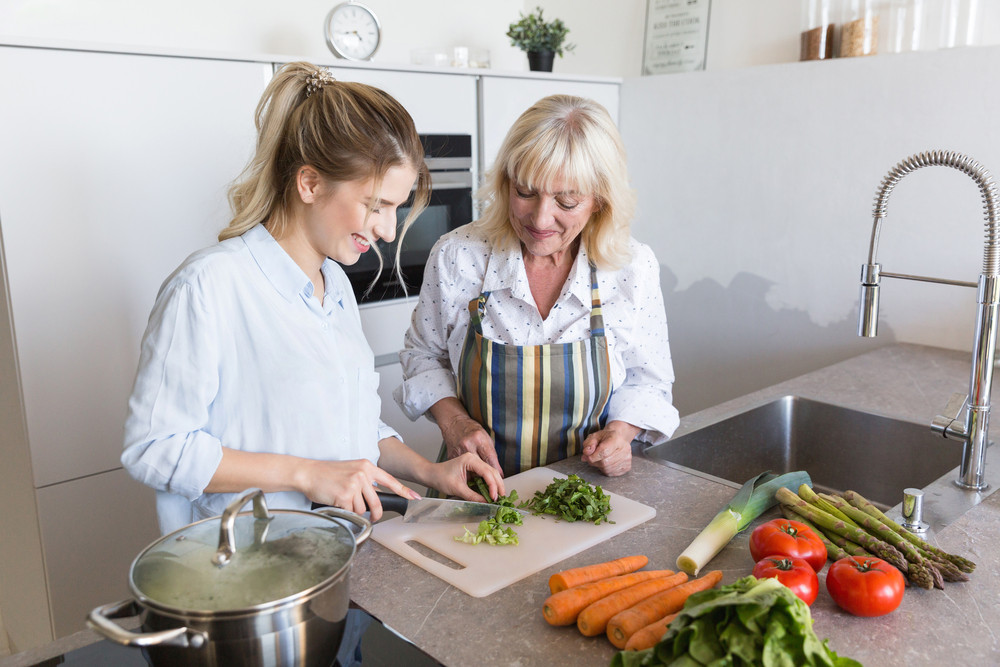
Cooking a great meal can be challenging. Even if you understand the basic elements of putting ingredients together, chances are there are some gaps in your knowledge. While reading a food magazine or visiting your favorite cooking website can help advance your skills, some basic knowledge just goes unsaid. Until now, that is. Whether you’re a pro in your kitchen or you’re just starting out, here are 10 kitchen tips you didn’t know you needed.
Taste and Salt as You Go
Even amateur chefs must understand the importance of tasting while cooking. Any new food magazine or cooking show can tell you that taste-testing your dishes is one of the best ways to achieve balance in your meals. However, it is often assumed that the only way to do so is near the end of the cooking process. Instead, according to experienced food and beverage consultants, it is far more helpful to taste test your meal as you are making it. This way you can avoid over or under salting your meal throughout.
As a basic guideline that is easy to remember, try taste testing and salting at each stage of your meal. That means if you need to mix ingredients and cook them on a stovetop, taste test before proceeding to the next step of placing the dish in the oven, etc. Making your adjustments in stages will help you avoid making any glaring mistakes. When you take a more measured approach to tasting and salting as you go, you give yourself the chance to create meals that achieve a perfect balance of flavors time and time again.
Be Present While You’re Cooking
 Cooking is as much about the end result as it is about the process itself. You might not think mindfulness and cooking go hand in hand, but you’d be wrong! While it is easy to fall into the step-by-step monotony of preparing a dish, you’ll probably find it far more enjoyable to stay present and enjoy every step of the process. Practicing mindfulness while you are cooking also has tremendous effects on the final meal that you produce. Whatever your approach, it has been shown time and time again that any type of mindfulness practice has incredibly positive effects on the brain. Yes, even while cooking.
Cooking is as much about the end result as it is about the process itself. You might not think mindfulness and cooking go hand in hand, but you’d be wrong! While it is easy to fall into the step-by-step monotony of preparing a dish, you’ll probably find it far more enjoyable to stay present and enjoy every step of the process. Practicing mindfulness while you are cooking also has tremendous effects on the final meal that you produce. Whatever your approach, it has been shown time and time again that any type of mindfulness practice has incredibly positive effects on the brain. Yes, even while cooking.
Taking on a regular mindfulness meditation practice outside of the kitchen will help you bring a genuine awareness into your cooking process, as well. Deep breathing techniques, guided meditation, and mantras are all fruitful techniques for developing your brain’s ability to notice details and remain present. Try starting out by setting aside just ten minutes per day. You just might be surprised at the progress you can make with such a small amount of time!
Work More Antioxidants into Your Food
While vitamins, minerals, and sufficient protein are common considerations of most people’s diets, antioxidants are all too often overlooked. Antioxidants are a critical pillar of any healthy diet. They help your body flush, cleanse, and detox itself. As an additional bonus, they also happen to be present in the types of foods that add unique flavors to dishes that might be lacking punch. Many berries such as raspberries, strawberries, and goji berries are excellent sources of antioxidants. But this does not mean that antioxidants are limited to fruits. Kale, dark chocolate, artichokes, and pecans also provide high amounts of antioxidants.
If you need ideas for finding foods rich in antioxidants, try reading a food magazine or visiting a local farmers market in your area. Buying local food at a certified farmers market will give you even greater access to a range of healthy ingredients. This might seem a little out there as far as kitchen tips you didn’t know you needed, but food is the best natural medicine for both your body and your mind. Why not help it along?
Try Foods That Are Good for Your Hair
There’s a lot of talk about foods that are good for your muscles, skin, and eyes, but eating foods that are good for your hair is equally as important! A lot of the foods that promote hair growth can be found in popular superfood lists in food magazines. This means that while such foods work to strengthen and support your hair, they also carry complex nutrient profiles that support overall health and well being. The list includes foods such as eggs, blueberries, sweet potatoes, and avocados.
Start small and local with your shopping list. As a challenge, try to purchase just one or two hair-healthy foods the next time you go grocery shopping. Taking a gradual approach is a great way to form any habit, especially those that have to do with your diet and your cooking. It could be a fun reminder to devise a shopping list that is organized by the different parts of the body. Thinking outside the box can lead to fun, unique innovations in the kitchen, many of which often turn out providing you with incredible health benefits!
Use Eco-Friendly Products in Your Kitchen
 As any modern food magazine, website, or blog will you show you, there are several different advantages to using eco-friendly cleaning products in your kitchen. First and foremost, you don’t have to worry about any potential chemical contamination of your counters, sink, and work surfaces. If you use chemical cleaners, you have to be extra diligent to ensure that the areas where you prepare food are clear of any harmful chemical residues. Eco-friendly cleaning products also help reduce your environmental footprint and contribute to a healthier planet.
As any modern food magazine, website, or blog will you show you, there are several different advantages to using eco-friendly cleaning products in your kitchen. First and foremost, you don’t have to worry about any potential chemical contamination of your counters, sink, and work surfaces. If you use chemical cleaners, you have to be extra diligent to ensure that the areas where you prepare food are clear of any harmful chemical residues. Eco-friendly cleaning products also help reduce your environmental footprint and contribute to a healthier planet.
Consulting your favorite food magazine or even local food suppliers can give you some good ideas about what type of products to look for and where to find them. In truth, almost every type of cleaning product that typically uses chemicals can be substituted with an eco-friendly alternative. If you’re really enthusiastic about natural cleaning products, you may even want to try making your own. Talk about kitchen tips you didn’t know you needed.
Plan Healthier Snacks
When you’re outside of the kitchen, it becomes more tempting to resort to eating junk foods for the sake of convenience. Whether you’re chaperoning a field trip to an educational museum or just running errands, resisting junk food can be tough. But you can combat these urges by being prepared. A good food magazine can give you tips on picking the right portion sizes and foods, but as a starting point, you should always consider packing whole foods. Things like grapes, carrots, and celery sticks are portable, delicious, and healthy. In the United States, people consume 31% more packaged food than fresh food. While packaged snacks are fine in moderation, fresh food is where it’s at.
Of course, the packaging you choose for field trip snacks is important too. Choosing foods that come in their own protective wrappers, like oranges and bananas, is a great starting point. You can also buy snacks that are easy to put into containers with lids for easy access. Thing things like berries, raisins, greens, and nuts. Mixing and matching snacks can also lead to some unique flavor combinations. Challenge yourself to find high-quality local food sources and pack only healthy snacks the next time you venture out for the day!
Store Alcohol Away from Sunlight
 When you store alcohol, whether in your kitchen or any other room, you should be sure that bottles are not exposed to sunlight. Not only can exposure to sunlight fade the color of your alcohol, but it can also alter the flavor. Distillers and vintners work hard to get both of these properties just right, so don’t ruin your liquor! Fortunately, it’s pretty easy to avoid exposure to sunlight for your alcohol. You can clean out a cupboard and turn it into dedicated storage for wine and spirits. Another option is installing windows that allow for dimmable tint. Protecting your alcohol from sunlight is crucial to preserve its life, quality, and flavor.
When you store alcohol, whether in your kitchen or any other room, you should be sure that bottles are not exposed to sunlight. Not only can exposure to sunlight fade the color of your alcohol, but it can also alter the flavor. Distillers and vintners work hard to get both of these properties just right, so don’t ruin your liquor! Fortunately, it’s pretty easy to avoid exposure to sunlight for your alcohol. You can clean out a cupboard and turn it into dedicated storage for wine and spirits. Another option is installing windows that allow for dimmable tint. Protecting your alcohol from sunlight is crucial to preserve its life, quality, and flavor.
Consider the types of wine or alcohol you use most often for cooking or for drinking. For certain cuisines that require lots of white wine, such as Italian dishes, you’ll want to pay special attention to the care of your cooking wine. And if you decide to drink some for yourself, you definitely don’t want to mar the taste of your favorite vintage.
Utilize Art in Your Kitchen
The right wall art can provide an immaculate environment for you and your dinner guests. Not only does wall art create a pleasant atmosphere, but it can also help stimulate hunger. Talk about a kitchen tip you didn’t know you needed. If you’re not sure what type of art to select, you may want to consult one of your favorite food magazines or websites to get some basic ideas. From there, you can apply your own personal tastes to guarantee your personality is represented throughout your kitchen or dining room.
While pictures of food can help to stimulate appetite, you’re definitely not limited to choosing wall art that includes food. Sometimes a nice landscape or abstract work can have similarly positive effects. At the end of the day, as long as you’re choosing something that aligns with your personal tastes and promotes a healthy eating environment, it’s hard to go wrong.
Monitor Your Electrical Use
Avoiding disasters in the kitchen isn’t always easy, but there are some steps you can take to put the necessary precautions in place, particularly when it comes to electricity. The last thing you want is an appliance that causes you to blow a fuse while you’re cooking. Thankfully, this can be avoided by setting up the right appliances and using a dependable residential electric service.
Getting some basic residential electric estimating done in your home can give you a more accurate picture of what your kitchen is capable of powering. Most electric companies are willing to provide accurate estimates with a quick, simple visit to your home. Doing so just might save you from blowing a fuse while you’re in the middle of making a big meal for family and friends. And while you’re at it, consider getting Energy Star approved appliances.
Set Your Table Before Eating
 When you prepare your table at the last minute, it tends to add unnecessary stress to the dining experience. Instead, it’s far more productive to set the table either before you begin cooking, or while you have some downtime with things set on a timer in the oven. When it comes to creating fun table arrangements, you can consult a food magazine or blog for ideas on stylish settings that can set your dining room apart from the typical setup. Feel free to test and experiment until you come up with a table setting that expresses your own sense of style.
When you prepare your table at the last minute, it tends to add unnecessary stress to the dining experience. Instead, it’s far more productive to set the table either before you begin cooking, or while you have some downtime with things set on a timer in the oven. When it comes to creating fun table arrangements, you can consult a food magazine or blog for ideas on stylish settings that can set your dining room apart from the typical setup. Feel free to test and experiment until you come up with a table setting that expresses your own sense of style.
It’s important for all aspects of cooking that you learn how to juggle multiple processes at once. Setting your table is no different. Try to practice setting up a few of your table’s components at different points throughout your cooking process. Eventually, you’ll find a flow that works best for you. Some people prefer to set the table before they even begin gathering ingredients. Others like to use the time they might have while things are cooking. It all depends on your personal workflow preferences, but over time you will come to discover which approach works best for you.
And there you have it! These 10 kitchen tips you didn’t know you needed could make all the difference in the way you cook and interact with your kitchen. You might even enjoy the finer details even more while you’re at it. Happy cooking!
Share This :

